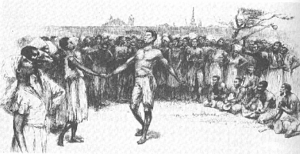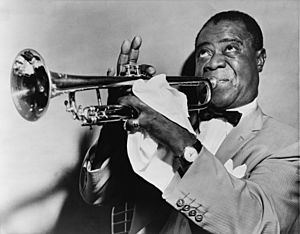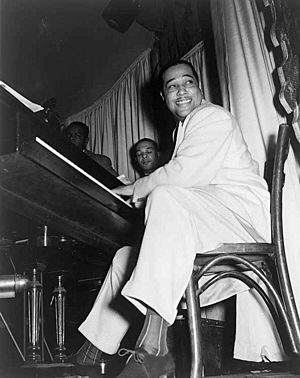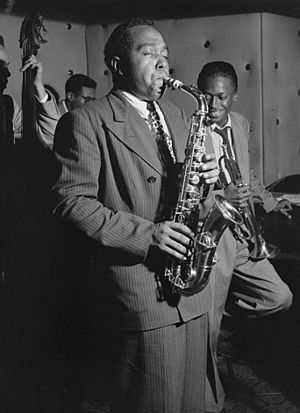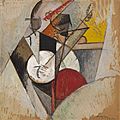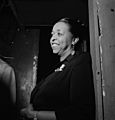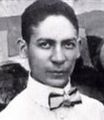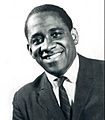Jazz facts for kids
Quick facts for kids Jazz |
|
|---|---|
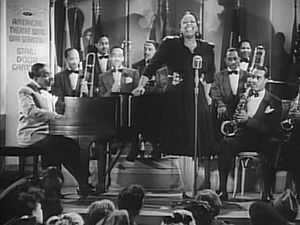
Count Basie with his orchestra and vocalist Ethel Waters, in the movie Stage Door Canteen 1943
|
|
| Stylistic origins |
|
| Cultural origins | Late 19th-century United States |
| Typical instruments |
|
| Derivative forms | |
| Subgenres | |
Jazz is a lively type of music that started in the United States. It mixes sounds from African-American music with ideas from European music. Jazz became popular in the 1910s and is still enjoyed today because of its many different styles.
Some common jazz instruments are the saxophone, trumpet, piano, double bass, and drums.
It's tricky to give one exact meaning for "jazz." The famous singer Nina Simone once said, "Jazz is not just music, it is a way of life." When we talk about jazz as music, a key part is improvisation. This means musicians make up music as they play. If a jazz band plays a song, one player might improvise a solo while others pause. Most jazz has a strong rhythm, called "swing," and often uses "blue notes." Blue notes are special musical sounds often heard in blues music.
Jazz began in the United States in the early 1900s. Its roots come from the music of African slaves who worked in the southern United States. This music included call and response songs, spirituals, and chants. These sounds helped create blues, which were often sad songs sung during labor. These influences came through earlier music styles like ragtime.
Jazz also uses musical ideas from European music. This includes brass and stringed instruments, and sometimes, musical notation (written music).
Over time, many different types of jazz have appeared. New Orleans jazz started in the early 1910s. Dixieland jazz was also popular. In the 1930s, swing jazz became huge, often played by big bands. In the 1940s, bebop became a main jazz style, known for fast songs and complex sounds.
Large jazz bands, called big bands, were very popular in the 1940s. A big band usually has many saxophone, trumpet, and trombone players. It also has a piano or guitar player, a bass player, a drummer, and sometimes a singer.
In the 1950s, hard bop jazz emerged. The 1960s brought modern jazz and free jazz. In the 1970s, jazz fusion started mixing jazz with rock music. Some jazz is still played with improvisation, but now it can use modern electronic instruments.
The History of Jazz Music

One big influence on jazz was blues music. Blues was a folk art that changed as black musicians moved to cities in the late 19th century.
Many early jazz musicians played in small marching bands. The instruments from these bands became the main instruments of jazz. These include brass, reed, and drums.
Early jazz also often used the structure and beat of marches. Marches were a common type of popular concert music around 1900.
Even though jazz has folk roots, some formally-trained musicians helped create it. Scott Joplin, who played ragtime piano, shows how different music styles mixed during this time.
An important event for jazz was when laws that separated people based on their race, called Jim Crow laws, became stricter in Louisiana in the 1890s. Talented musicians of mixed race could no longer work with white musicians. But they easily found work in black bands and orchestras.
Before World War I, public dance halls and clubs opened in cities. Black dances like the cakewalk and the shimmy became popular with white people, especially young women called flappers. White audiences first saw these dances in vaudeville shows.
Popular composers like Irving Berlin tried to write jazzy music. Berlin's hit song "Alexander's Ragtime Band" in 1911 helped make jazz famous. Even though the song wasn't true ragtime, its lyrics described a jazz band.
Phonograph records made new music available everywhere. Through some recordings for black audiences, Louis Armstrong brought a big change to jazz. He was an amazing improviser, able to create endless new versions of a melody. Other musicians copied him, and jazz became more about solo playing.
Jazz music was still a mix of things, like dance numbers and show tunes. The Ellington band at the Cotton Club and the Count Basie band from Kansas City started around this time.
Racial separation in music began to lessen in the mid-1930s. This happened when Benny Goodman hired black musicians like pianist Teddy Wilson and guitarist Charlie Christian for his small groups. In the mid to late 1930s, swing music and big band music were very popular. They made stars out of musicians like Glenn Miller and Duke Ellington. Swing was the most popular music of this time.
Boogie-woogie music used a fast, doubled rhythm. The rhythm section played eight beats per measure instead of four. Big Joe Turner, a singer from Kansas City, worked with swing bands in the 1930s. He became a boogie-woogie star in the 1940s. In the 1950s, he was one of the first to help create rock and roll with songs like "Shake, Rattle and Roll".

The next big change in jazz was bebop, led by saxophonist Charlie Parker, also known as "Bird." This style shifted jazz from dance music to a more artistic, intellectual form. Hard bop tried to make bebop more appealing by adding sounds from soul music, gospel music, and the blues. Later bebop and hard bop musicians, like trumpeter Miles Davis, developed modal jazz. In this style, musicians would improvise using a specific mode (a type of scale). Soul jazz was a type of hard bop that often featured the Hammond organ.
Free jazz was an experimental way to play jazz improvisation. It started in the late 1950s and early 1960s. Musicians like John Coltrane tried to change or break traditional jazz rules. This included regular tempos, tones, and chord changes.
As rock and roll grew in the 1960s, a new mixed style called jazz-rock fusion appeared. Miles Davis was also involved in this. Jazz-rock fusion combined jazz improvisation with rock rhythms, electric instruments, and the loud stage sound of rock musicians like Jimi Hendrix and Frank Zappa.
Latin jazz mixes jazz harmonies and ideas with rhythms and instruments from Africa and Latin America. Examples include Brazilian jazz and Afro-Cuban jazz. These forms are definitely jazz because they involve a lot of improvisation.
Harry Connick Jr. started his career playing stride piano and the Dixieland jazz from his hometown, New Orleans. He made his first recording when he was just ten years old.
International Jazz Day
April 30 is celebrated as "International Jazz Day." Each year, jazz concerts and educational events happen around the world. This day helps people learn more about jazz. The United Nations Education and Science Organization (UNESCO) also takes part. People celebrate this day because they believe jazz history is connected to peace, freedom, and equality.
Images for kids
-
American jazz composer, lyricist, and pianist Eubie Blake.
-
Albert Gleizes, 1915, Composition for "Jazz" from the Solomon R. Guggenheim Museum, New York.
-
Ethel Waters sang "Stormy Weather" at the Cotton Club.
-
Al Jolson in 1929.
-
W. C. Handy at 19, 1892.
-
The Bolden Band around 1905.
-
Jelly Roll Morton, in Los Angeles, California, c. 1917 or 1918.
-
Peter Brötzmann is a key figure in European free jazz.
-
Naná Vasconcelos playing the Afro-Brazilian Berimbau.
-
Fusion trumpeter Miles Davis in 1989.
-
David Sanborn, 2008.
-
John Zorn performing in 2006.
See also
 In Spanish: Jazz para niños
In Spanish: Jazz para niños



